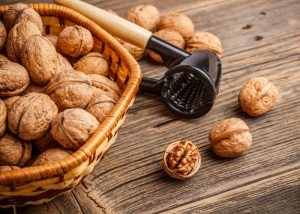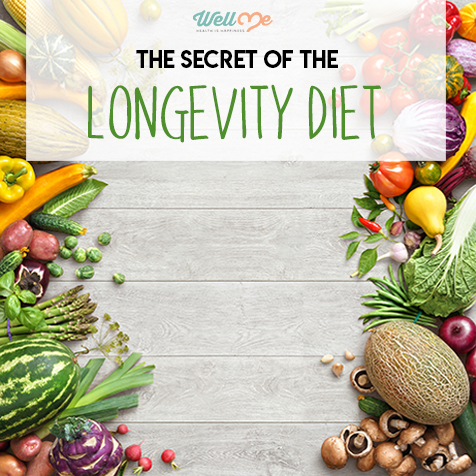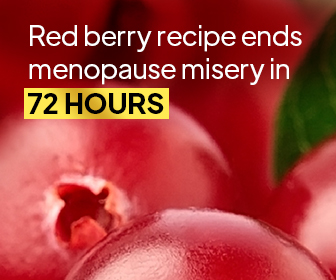You may have heard about fasting-mimicking diets that help you lose weight while increasing the vitality and longevity of your life. You may have also thought they represented another fad in the diet world. However, the Longevity Diet Plan is worth paying attention to. It provides scientifically supported data to back up its claims of lowering your risk of disease, helping you lose weight, and even adding years to your life.
U.S. researchers set out to interview the “world’s healthiest people” to investigate the secret to human longevity.[1] Those they researched that have all lived to be over 100 years old, or centenarians, all had one thing in common: their diet and exercise regimen. They ate lots of plant-based foods and lean meat, and they kept themselves moving.
The Longevity Diet Plan uses this information and identifies what we can do to create the same environments in our own homes. We’ll explore how it works, why it’s healthy for you, and what you can expect to gain by making this lifestyle change. We’ll also break down the guidelines of the plan and give you a few steps to get you started on this journey to a longer life. Let’s go!
What is the Longevity Diet Plan?

The Longevity Diet Plan (LDP) is a diet and exercise program which includes a healthy eating strategy, a fasting-mimicking diet, and recommendations regarding movement and exercise. Don’t worry, you’ll like what this plan has to say about exercise!
The Longevity Diet is the result of 25 years’ worth of research on aging, nutrition, and disease. It is designed to extend human longevity and to make sure that you’re healthy enough to enjoy all those extra years you will gain by following the program. The LDP not only helps you lose weight and abdominal fat, it also helps you keep it off. Furthermore, it prevents age-related muscle and bone loss, builds resistance to diabetes, Alzheimer’s disease, cancer, and cardiovascular disease.[2]
A Simple, Adoptable Diet Plan
The basics of the plan include a calorie-restricting pescatarian diet (which means avoiding all meat except for fish). This combines the benefits of nutritious food with an effective method of fasting that won’t leave you hungry, tired, or dissatisfied. Proper calorie restriction leads to a longer, healthier life.
Fewer Calories
You will cut your calories by about 25% through choosing wholesome, low-glycemic, high-fiber foods. These foods include fruits and vegetables, nuts and seeds, and lean proteins. You will avoid processed foods, sugar, and heavy starches, and instead learn to enjoy foods rich in healthy fats, vitamins, and minerals.
A Better Way to Fast
Besides eating healthy on a daily basis, you will fast three to four times per year, for five days at a time. However, this is not the fasting you may be used to, which leaves you tired, grumpy, and starved. It is a scientifically engineered fasting-mimicking diet (FMD), which is much gentler on your system.
Understanding the Importance of Diet for Human Longevity

The best diet for longevity will replace harmful foods with healthy ones. Following a fasting diet also helps you lose and keep off extra weight and fat. As a result, you get to live a healthier, longer life.[3]
According to research by the National Institute of Health (NIH), some leading causes of death among Americans include cardio metabolic diseases like stroke, type 2 diabetes, and heart disease. The NIH points out that the risk of death from these diseases are connected to ten dietary factors.
High consumption of sodium (found in processed meat and salty snacks), sugar (especially added sugars like those in sugar-sweetened beverages), and trans fats (such as those found in baked and fried foods) were all linked with a higher risk of being diagnosed with these cardio metabolic diseases. The consumption of fruits, vegetables, whole grains, fish, nuts, eggs, and beans lowered the risks.
Data from the CDC’s National Health and Nutrition Examination Survey (NHANES) revealed that 45% of deaths were due to cardio metabolic diseases caused by poor eating habits. Science continues to offer increasing evidence that a diet which follows the guidelines – such as those in the Longevity Diet Plan – is key to human longevity.
Fun Fact: By following 10 dietary guidelines, you can lower your risk of cardio metabolic diseases like stroke, type 2 diabetes, and heart disease.
Tips for Creating the Best Diet for Longevity
In any diet, there are basic rules for success, and this one is no exception. The biggest success factor in the Longevity Diet is understanding what to eat, how to eat it, and when to eat it. Choose items from the lists below that you already like and incorporate them into your everyday meals now.
Plant-Based

Want to know a secret to human longevity? Fresh vegetables – lots of them. The best diet for longevity emphasizes plant-based foods and you will do well by eating unprocessed, low-carb, low-starch plants that are fresh or lightly cooked.
Things to include:
- Artichokes
- Cabbage
- Tomatoes
- Zucchini
- Eggplant
- Peppers
- Pumpkin
- Lots of herbs and spices (like basil, oregano, and sage)
Things you should limit:
- Potatoes
- Grains
- Beans
- Salt
Low (and Lean) Protein

A low amount of lean protein, such as the kind found in fish and pasture-raised eggs, is an essential building block of the Longevity Diet. Try to limit dairy products to the occasional grass-fed butter, goat and sheep cheese, or yogurt. This diet can also help you discern a suitable amount of protein intake for your body mass.
Things to include:
- Low-fat dairy products
- All kinds of fish (Snapper, Salmon, Trout)
- Skinless poultry
Things you should limit:
- Fried foods
- Butter or margarine
- Red meat
Healthy Fats

One great thing about the Longevity Diet Plan is that it recognizes the importance of essential fatty acids and Omega-3 fats for health and human longevity. Enjoy fats that come from plants like coconut, olives, avocados, nuts, and seeds. Include two to three servings of fatty fish in your diet every week. These fish include salmon, sole, mackerel, and sardines. Avoid eating saturated, hydrogenated, and trans fats.
Things to include:
- Olive oil
- Plain almonds, walnuts, or cashews
- Natural peanut butter
- Tahini
- Hummus
Things you should limit:
- Candied or salted nuts
- Other oils (vegetable, canola)
- Processed snack foods (meat snacks)
Selecting Carbs

Eating better doesn’t mean you have to cut out carbs completely, it just means you have to be more selective about the types of carbs you eat. It is best to limit your sugar intake by refraining from pasta, rice, white bread, and fruit juices. Consider choosing more complex carbs such as those found in wholegrain bread, legumes, and vegetables.
Things to include:
- Chickpeas
- Spelt
- Wheat flour
- Raisins
- Pine nuts
Things you should limit:
- Fruity beverages (orange juice, smoothies, fruit drinks with lots of extra sugar)
- Bread
- Rice
- Pasta
- Pre-packaged foods (cookies, cakes, crackers)
- Sugar
- Flour tortillas
Eat Less Often

This diet plan recommends that you eat less often. By regulating your daily food intake, your healthy food choices become habitual, and you’ll eat more of the good stuff, leaving out the unhealthy options.
Limit your meals to two a day plus a snack. This includes a healthy and nutrition-packed breakfast, one major meal during the day, and one low-calorie snack. If you can, it’s advisable to avoid skipping breakfast.
For example, the creator of the Longevity Diet, Dr. Valter Longo, eats the same breakfast every morning: one green tea bag, one black tea bag, a squeeze of lemon, and low-sugar fruit jam on cinnamon raisin toast.[4]
Fasting-Mimicking

A fasting diet has been linked to lowered risk of cancer, diabetes, and cardiovascular diseases. This part of the Longevity Diet involves a structured five-day fast three to four times per year. Those who embrace this diet will see the most improvement in their health after the first three cycles.
They call it fasting mimicking because it is not a full fast in the traditional sense. Instead, your body gets the benefits of fasting without going to extreme measures of withholding food.
Time-Restricted Meals

For fasting-mimicking to work, limit all eating to a specific window of time (for example, 12 hours), and avoid eating during the rest of the day. Eat breakfast after 8 am and finish dinner before 8 pm. After that, avoid eating until breakfast the next day. For more effective weight loss results, you can shorten this time frame even more. Avoid eating three to four hours before bed, or you may have trouble sleeping.
Health Benefits of Fasting (or “Fasting-Mimicking”)
Fasting is easy and useful for human longevity and here’s why:
Weight Loss

Fasting is a great way to lose weight. Recent studies have shown that decreasing calories and consuming nutrient-dense foods decreases body fat and overall weight.[5] You’ll be more in-tune with your body and your hunger signals.
Reducing Hunger
It can be difficult to lose weight or feel energetic if you’re always hungry. The good news is that fasting actually reduces your appetite.[6] The hormone known as Ghrelin is what makes you feel hunger and, by fasting, you can stabilize this hormone.
Enhanced Cognitive Performance and Health
Studies have shown that fasting-mimicking diets promote the regeneration of neurons in the brain and decrease signs of aging.[7] This diet will make you smarter and feel younger! Ingredients encouraged in the Longevity Diet Plan (such as olive oil), also have several brain-boosting effects such as improved cognitive function, learning, and memory.[8]
Potential Prevention and Reversal of Cancer, Diabetes and Multiple Sclerosis

Recent studies suggest that diets that incorporate elements of fasting may help reduce the risk of chronic disease. One study from 2017 looked at 100 healthy patients to see what the effects of a fasting-mimicking diet would be. They reported no adverse effects, and participants lost both body weight and body fat. Added benefits included better blood pressure, fasting glucose, and cholesterol levels.[9]
A 2016 study shows that a fasting-mimicking diet may prevent damage to the myelin sheath which protects the brain and spinal cord, decreasing the risk of multiple sclerosis.[10]
Fasting-Mimicking vs. Fasting
There is a difference between fasting and fasting-mimicking diets. Both involve caloric restriction and many of the same health benefits, but there are differences. For example, a fasting diet can be so severe that it cannot be maintained for too long or repeated too often. A fasting-mimicking diet lasts only for a five-day stretch and can easily be sustained without misery. You can repeat this several times a year without feeling deprived.
Research has shown that long-term calorie restriction and starvation fasting can be harmful, even leading to metabolic damage. A fasting-mimicking diet is a better choice because it allows you to consume small amounts of certain foods during the fasting period. This allows the body to keep enough nutrients and electrolytes, manage stress and hunger, and protect the metabolic system.[11]
Fun Fact: A recent study has shown that a fasting-mimicking diet like the LDP may prevent severe chronic illnesses to occur, such as cancer or diabetes.
Should You Try the Longevity Diet?
With all this new information, you may wonder if the Longevity Diet Plan is right for you.
If you want to make a long-term change to your lifestyle, then the LDP may be just right for you. You will increase the nutrients in your diet, lose weight, and feel healthier and more energized in the long-run. If you are looking for a quick-fix diet that will solve a problem in the short term, however, this is not likely to be a good fit.
The LDP recommends only moderate exercise due to the need for higher caloric intake when exercising.[12] So, if you need lots of exercise in your normal routine, this may not be the best diet plan for you.
If you cannot follow specific guidelines over an extended period, you will find less success on this diet. Following the Longevity Diet Plan requires forethought and planning. You should not start this diet when you’re planning to attend an event where you are unable to make deliberate food choices, like a wedding, or a birthday party.
How is it Better than Other Diet Plans?

If you crave a structured, long-term diet plan with specific guidelines and little time or energy allotted for exercise, the LDP may be an excellent fit for you. By following easy-to-understand rules, like eating plant-based foods, healthy fats and lean proteins, you’ll feel better, look better, and live longer. This, combined with elements of fasting, could help you lose weight, decrease your risk of disease, and add more healthy and enjoyable years to your life.
Getting the Most Out of Your Longevity Diet
- First, talk to your doctor! Resolve any health issues before starting any new diet plan.
- Choose a good time to make the change. If you’re experiencing a higher than usual amount of work or stress, this may not be the best time to try the Longevity Diet Plan. Instead, choose a time when you know you’ll have the time and energy necessary for a significant lifestyle change.
- Next, talk to your friends and family. Make sure the people around you know what you’ll be doing and why it is important to you, so they can support your choices. Perhaps you’ll even be able to recruit a few supportive partners who can join you.
- Decide your desired outcomes. Figure out what you want most out of this change. Do you want to lose a certain amount of weight or body fat? Or maybe you want to increase your energy? Write out a few measurable goals that will help keep you on task throughout the diet.
- Plan, plan, plan. The best diet for human longevity will incorporate plant-based foods, light activity, and occasional fasting periods. Increase the recommended foods in your diet and decrease restricted foods.
- Finally, once you have adapted to the changes in food, add light activity such as walking or yoga to your day. Then, do three to four fasting-mimicking periods throughout the year. Once you have completed these steps, you’ll have successfully switched to the Longevity Diet Plan.

Start Living Longer
Incorporating this new diet may not be easy at first, but with the right amount of preparation and continued effort, you can make this critical and worthwhile change in your lifestyle. You will experience the benefits of longer years and a healthier you!
Want to learn more about the health benefits of fasting? Check out our guide to intermittent fasting!
References
- [1] “Eating To Break 100: Longevity Diet Tips From The Blue Zones.” Eliza Barclay. https://www.npr.org/sections/thesalt/2015/04/11/398325030/eating-to-break-100-longevity-diet-tips-from-the-blue-zones
- [2] “The Longevity Diet by Valter Longo.” Penguin Random House. <https://www.penguinrandomhouse.com/books/564866/the-longevity-diet-by-valter-longo/9780525534075/>
- [3] “How Your Eating Habits Affect Your Health.” NIH. <https://newsinhealth.nih.gov/2017/05/how-your-eating-habits-affect-your-health>
- [4] “Fasting Mimicking Diet Could Fight Disease, Increase Longevity: 9 New Questions for Dr. Longo.” https://www.bluezones.com/2018/01/the-longevity-diet/
- [5] “Fasting Mimicking Diet Do-it-Yourself Guide.” Forever Free From. <http://foreverfreefrom.com/fasting-mimicking-diet-guide/>
- [6] “Ghrelin: How to Control This ‘Hunger Hormone’ in Order to Lose Fat.” Dr. Axe. https://draxe.com/ghrelin/
- [7] “A periodic diet that mimics fasting promotes multi-system regeneration, enhanced cognitive performance and healthspan.” NCBI. https://www.ncbi.nlm.nih.gov/pmc/articles/PMC4509734/
- [8] “Virgin olive oil supplementation and long-term cognition: the PREDIMED-NAVARRA randomized, trial.” NCBI. <https://www.ncbi.nlm.nih.gov/pubmed/23732551>
- [9] “Fasting-mimicking diet and markers/risk factors for aging, diabetes, cancer, and cardiovascular disease.” NCBI. <https://www.ncbi.nlm.nih.gov/pubmed/28202779/>
- [10] “Diet mimicking fasting promotes regeneration and reduces autoimmunity and multiple sclerosis symptoms.” NCBI. <https://www.ncbi.nlm.nih.gov/pmc/articles/PMC4899145/>
- [11] “What is a Fasting Mimicking Diet and How to Do It.” Perfect Keto. <https://www.perfectketo.com/fasting-mimicking-diet-and-how-to-do-it/>
- [12] “What Exercise is Best for Optimal Health and Longevity?” Dr. Valter Longo. https://www.bluezones.com/2018/01/what-exercise-best-happy-healthy-life/
- Fun Fact: “How Your Eating Habits Affect Your Health.” NIH. Mary 2017. <https://newsinhealth.nih.gov/2017/05/how-your-eating-habits-affect-your-health>
- Fun Fact: “Fasting-mimicking diet and markets/risk factors for aging, diabetes, cancer, and cardiovascular disease.” NCBI. 15 February 2017. <https://www.ncbi.nlm.nih.gov/pubmed/28202779>








